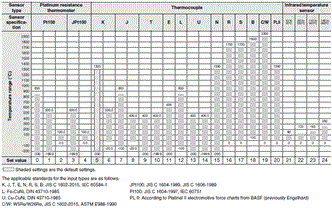| Power supply voltage | A in model number: 100 to 240 VAC, 50/60 Hz
D in model number: 24 VAC, 50/60 Hz; 24 VDC |
|
|---|---|---|
| Operating voltage range | 85% to 110% of rated supply voltage | |
| Power consumption | 6.6 VA max. at 100 to 240 VAC, and 4.1 VA max. at 24 VAC or 2.3 W max. at 24 VDC | |
| Sensor input | Temperature input
Thermocouple: K, J, T, E, L, U, N, R, S, B, C/W, or PL II Platinum resistance thermometer: Pt100 or JPt100 Infrared temperature sensor (ES1B): 10 to 70°C, 60 to 120°C, 115 to 165°C, or 140 to 260°C Analog input Current input: 4 to 20 mA or 0 to 20 mA Voltage input: 1 to 5 V, 0 to 5 V, or 0 to 10 V |
|
| Input impedance | Current input: 150 Ω max., Voltage input: 1 MΩ min.
(Use a 1:1 connection when connecting the ES2-HB-N/THB-N.) |
|
| Control method | ON/OFF control or 2-PID control (with auto-tuning) | |
| Control
output |
Relay output | SPST-NO, 250 VAC, 5 A (resistive load), electrical life: 100,000 operations,
minimum applicable load: 5 V, 10 mA |
| Voltage output
(for driving SSR) |
Output voltage: 12 VDC ± 20% (PNP), max. load current: 40 mA, with short-circuit
protection circuit (The maximum load current is 21 mA for models with two control outputs.) |
|
| Linear current
output |
4 to 20 mA DC/0 to 20 mA DC, load: 500 Ω max., resolution: approx. 10,000 | |
| Auxiliary
output |
Number of outputs | 1, 2, or 3 (depends on model) |
| Output
specifications |
SPST-NO relay outputs, 250 VAC, Models with 2 outputs: 3 A (resistive load),
Electrical life: 100,000 operations, Minimum applicable load: 10 mA at 5 V |
|
| Event
input |
Number of inputs | 2 or 4 (depends on model) |
| External contact
input specifications |
Contact input: ON: 1 kΩ max., OFF: 100 kΩ min. | |
| Non-contact input: ON: Residual voltage: 1.5 V max., OFF: Leakage current: 0.1 mA max. | ||
| Current flow: Approx. 7 mA per contact | ||
| Potentiometer input | 100 Ω to 10 kΩ | |
| Setting method | Digital setting using front panel keys | |
| Indication method | 11-segment digital display and individual indicators
Character height: PV: 18.0 mm, SV: 11.0 mm |
|
| Multi SP | Up to eight set points (SP0 to SP7) can be saved and selected using event inputs, key
operations, or serial communications. |
|
| Bank switching | None | |
| Other functions | Manual output, heating/cooling control, loop burnout alarm, SP ramp, other alarm
functions, heater burnout (HB) alarm (including SSR failure (HS) alarm), 40% AT, 100% AT, MV limiter, input digital filter, self tuning, PV input shift, run/stop, protection functions, temperature status display, moving average of input value, FB moving average |
|
| Ambient operating
temperature |
-10 to 55°C (with no condensation or icing),
for 3-year warranty: -10 to 50°C (with no condensation or icing) |
|
| Ambient operating humidity | 25% to 85% | |
| Storage temperature | -25 to 65°C (with no condensation or icing) | |
| Altitude | 2,000 m max. | |
| Recommended fuse | T2A, 250 VAC, time lag, low shut-off capacity | |
| Installation environment | Installation Category II, Pollution Class 2 (IEC 61010-1 compliant) | |
























